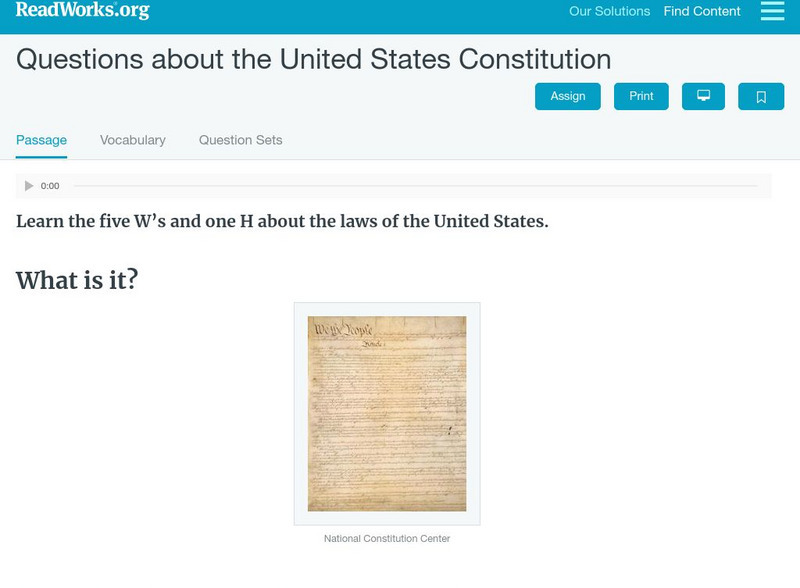Hi, what do you want to do?
Curated OER
Do You want? Do You Like? There is/ There are
Pupils understand and recognize the names of various foods. In this food bingo instructional activity, students work in pairs to practice questioning with the phrases: do you want and do you like. Pupils practice listening and speaking...
Curated OER
What Is a Newspaper?
In this journalism activity, learners read and analyze an article about newspapers and complete a variety of activities along with answering twenty four comprehension questions.
Curated OER
Fish Counting Nursery Rhyme
Students experience The Fish Counting Rhyme. In this counting instructional activity, students practice counting while listening to The Fish Counting Rhyme.
Curated OER
The Name Jar
Students participate in a lesson that focuses on the literature of Korea. "The Name Jar" is read by students to practice some essential reading skills. This would include the recognition of sequence in a story, characterization, and...
Curated OER
Short Story
Seventh graders identify the various elements of a short story. After reading Rudyard Kipling's short story, "Rikki-Tikki-Tavi," students identify the author's purpose in writing the story as well as the elements that make it a short...
Curated OER
Moral Dilemmas
In this moral dilemmas worksheet, students will cut apart 16 question cards. Then they will take turns reading scenarios about situations involving using one's morals and discuss how they would handle these situations.
Curated OER
It's Raining Cats and Dog: Studying Idioms
Seventh graders determine the literal and figurative meanings of idioms and research the history of idioms. In this idioms instructional activity, 7th graders read two books by Fred Gwynne and select two idioms from the texts to...
Curated OER
Short Story 2
Seventh graders review previous reading of Rikki Tikki Tavi. They discuss prior knowledge of simile, metaphor, idiom, and hyperbole. Students practice using vocabulary words from the story by listing synonyms for them. Students read from...
Curated OER
Class Field Guide to the Sloughs
Students explore how to use field guides to identify wildlife. In this nature lesson students construct their own plant field guide.
Curated OER
Vocabulary Building: "ai" Words
In this identifying words spelled with "ai" worksheet, students use definition clues, unscramble letters, and create sentences using the words main, hail, straight, trailer, remain, railroad, and maintenance. Students write twenty-one...
Curated OER
Traveling Through Time, Wetland Style
Students create a timeline on the development of the Pajaro Valley Area. In this social science lesson, students discuss the changes that took place in the area over the past 300 years. They draw a pictures of how the area has changed...
Curated OER
Summary Lesson Plans
Students can learn how to write summaries with the help of graphic organizers, and summarization lessons.
Curated OER
Vocabulary Building: ar
In this vocabulary "ar" worksheet, students write the new words as "definition clues" are given by the teacher, unscramble the new words, and use words in sentences that show meaning. Worksheet has 4 sets of 7 words each, same activities...
Curated OER
Vocabulary Building: 2 Consonant Rule
In this consonant rule vocabulary worksheet, students write the new words as "definition clues" are given by the teacher, unscramble the new words, and use words in sentences that show meaning. Worksheet has 4 sets of 7 words each, same...
Curated OER
Lesson Ideas for Comparing and Contrasting Content
Here are three lesson ideas to help students learn how to compare and contrast information in any content area
Curated OER
Lesson 3: Writing a News Story
Start a writing lesson by examining a news video that explains writing clearly, concisely, and correctly. Learners consider the importance of writing news properly to avoid breaking the law, then write their own weekend news stories.
Curated OER
The Importance of Punctuation
In this writing worksheet, learners participate in a variety of punctuation activities. For example, rewrite a text using correct punctuation and unscramble words to create sentences.
Curated OER
Produce a Nonfiction Text
In this language arts worksheet, students look for the facts and create several nonfiction texts while including useful information for the reader.
Enchanted Learning
Enchanted Learning: 5 W's Diagrams
Enchanted Learning provides several examples of graphic organizers that can be used for gathering Who, What, Where, When, and Why information, either for reading comprehension or prewriting. These template suggestions can only be printed...
Education Place
Houghton Mifflin: Eduplace: 5 Ws Chart [Pdf]
This site from Houghton Mifflin Company provides a simple, reproducible chart to help students gather details of Who, What, When, Where, and Why. This could be used as a reading comprehension tool, or as prewriting for expository writing.
Read Works
Read Works: Our Constitution
[Free Registration/Login Required] An informational text giving facts about the Constitution of the United States. A question sheet is available to help students build skills in reading comprehension.
Michigan State University
Michigan State University: Intervention for Reading: Story Grammar Training
This intervention emphasizes the importance of metacognitive or active reading strategies to improve comprehension. It directs young scholars' attention on story structure by teaching them to ask five "wh" questions about the settings...
PBS
Pbs Teachers: Story Writing With Arthur
This series of 12 downloadable activities teach students some basics of story writing, using books or videos from the PBS "Arthur" series as a springboard. Activities include creating story maps, asking questions about characters and...
Wisconsin Response to Intervention Center
Wisconsin Rt I Center: Event Map [Pdf]
Teachers will learn how to use event maps with students. They will learn how to implement event maps with literary and informational texts; measure progress with event maps; and find research to support event maps. A reproducible event...
























![Houghton Mifflin: Eduplace: 5 Ws Chart [Pdf] Graphic Houghton Mifflin: Eduplace: 5 Ws Chart [Pdf] Graphic](https://static.lp.lexp.cloud/images/attachment_defaults/resource/large/FPO-knovation.png)


